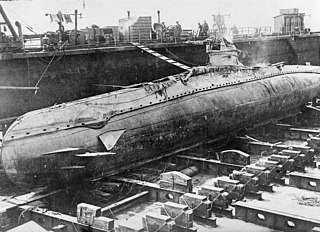
The Electric Telegraph Company (ETC) was a British telegraph company founded in 1846 by William Fothergill Cooke and John Ricardo. It was the world's first public telegraph company. The equipment used was the Cooke and Wheatstone telegraph, an electrical telegraph developed a few years earlier in collaboration with Charles Wheatstone. The system had been taken up by several railway companies for signalling purposes, but in forming the company Cooke intended to open up the technology to the public at large.

A cable layer or cable ship is a deep-sea vessel designed and used to lay underwater cables for telecommunications, electric power transmission, military, or other purposes. Cable ships are distinguished by large cable sheaves for guiding cable over bow or stern or both. Bow sheaves, some very large, were characteristic of all cable ships in the past, but newer ships are tending toward having stern sheaves only, as seen in the photo of CS Cable Innovator at the Port of Astoria on this page. The names of cable ships are often preceded by "C.S." as in CS Long Lines.

The Arabis class was the third, and largest, of the five sub-classes of minesweeping sloops completed under the Emergency War Programme for the Royal Navy in World War I. They were part of the larger "Flower class" shipbuilding project, which were also referred to as the "Cabbage class", or "Herbaceous Borders". The ships were also used outside their minesweeping duties as patrol vessels, tugs, and personnel and cargo transports.

SM UC-5 was a German Type UC I minelayer submarine or U-boat in the German Imperial Navy during World War I. The U-boat had been ordered by November 1914 and was launched on 13 June 1915. She was commissioned into the German Imperial Navy on 19 June 1915 as SM UC-5. She served in World War I under the command of Herbert Pustkuchen and Ulrich Mohrbutter.

SS De Grasse was an ocean liner built in 1921 by Cammell Laird, Birkenhead, United Kingdom for the Compagnie Generale Transatlantique, and launched in February 1924. In August 1924 The De Grasse set sail on her maiden voyage on the Le Havre to New York route. After the fall of France to Nazi germany, the ship was use as a floating barracks ship. Sunk at Bordeaux, France, during the German retreat, she was refloated, repaired and put back into service. Over the years and shipowners, she became the Empress of Australia and then Venezuela. The vessel ran aground off Cannes, France, in 1962 and was scrapped at La Spezia, Italy.

Dieppe was a steam passenger ferry that was built in 1905 for the London, Brighton and South Coast Railway. She was requisitioned during the First World War for use as a troopship and later as a hospital ship HMS Dieppe, returning to her owners postwar. She passed to the Southern Railway on 1 January 1923. In 1933 she was sold to W E Guinness and converted to a private diesel yacht, Rosaura. She was requisitioned in the Second World War for use as an armed boarding vessel, HMS Rosaura. She struck a mine and sank off Tobruk, Libya on 18 March 1941.
Several steamships have borne the name Donau, after the German name for the river Danube:
Several steamships have borne the name Selma:
Several steamships have borne the name Sirius:
Several steamships have borne the name Westfalen, after the Westphalia region in Germany:
Several steamships have borne the name Stella:

HMCS Trentonian was a modified Flower-class corvette that served with the Royal Canadian Navy during the Second World War. She fought primarily in the Battle of the Atlantic and the English Channel as a convoy escort. She was named for Trenton, Ontario, though due to a naming conflict with another vessel, her name was changed. She was sunk in 1945.
Five steamships have borne the name Bosnia, after Bosnia:

The British SS Lord Kelvin was a cable-laying ship which served during the Second World War. Initially owned by the Anglo-American Telegraph Company, Lord Kelvin was completed in 1916. Sold the same year to Transatlantic Cables, the ship spent the rest of her life laying cables until taken out of service in 1963 and broken up in 1967.
Four cable-laying ships have been named CS Alert:

CS Alert, or HMTS Alert, was a cable-laying ship that had a significant role in World War I. She was launched in 1871 for the Submarine Telegraph Company with the name The Lady Carmichael. In 1890 the ship was acquired by the General Post Office (GPO) as part of the nationalisation of the British telegraph network. At the outbreak of World War I, Alert was immediately dispatched to cut German telegraph cables in the English Channel, seriously damaging Germany's ability to securely communicate with the rest of the world. Alert was taken out of service as a cable ship in 1915 but her cable-handling gear was retained for fitting on her replacement. After the war, she worked as a merchant ship under various names, finally being wrecked at Redcar under the name Norham in 1932.
The Submarine Telegraph Company was a British company which laid and operated submarine telegraph cables.
HMTS Monarch, launched on 8 August 1945 and completed during February 1946, was the fourth cable ship with that name. The ship was built for the General Post Office (GPO) for the laying and repair of submarine communications cable and was the largest cable ship in the world when completed and the first cable ship to have all electric cable machinery.









